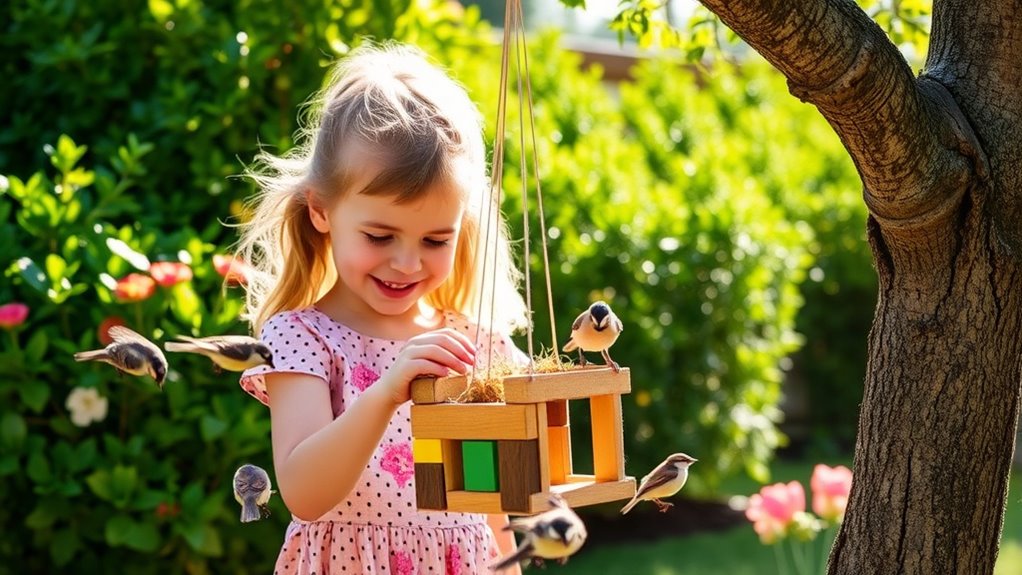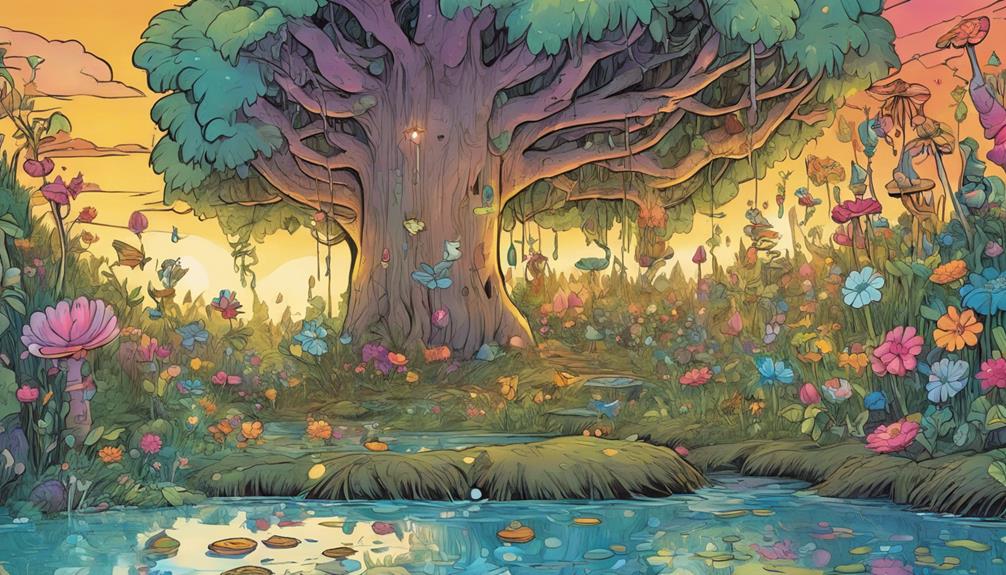Encouraging your kids to build bird feeders and care for wildlife helps them learn about nature while developing responsibility and patience. Hands-on projects, like using recycled materials or natural supplies, make it fun and meaningful. Kids will enjoy watching birds, observing their habits, and understanding ecosystems. These activities also foster environmental awareness and pride. Keep exploring to find simple ways to turn these experiences into lifelong passions your children will cherish.
Key Takeaways
- Involving kids in building bird feeders teaches responsibility, patience, and environmental stewardship through hands-on activities.
- Using recycled and natural materials promotes sustainability and creativity in creating functional wildlife feeders.
- Bird watching and feeder maintenance foster curiosity about local bird species and ecosystems.
- Creating a wildlife-friendly backyard with feeders and native plants encourages ongoing conservation efforts.
- Engaging children in seasonal wildlife care activities builds lifelong awareness and appreciation for nature.

Getting kids involved in building bird feeders and caring for wildlife is a wonderful way to teach them about nature and responsibility. When you encourage them to observe birds through bird watching, they develop patience and an eye for detail. Creating bird feeders becomes a fun, hands-on activity that combines learning with creativity. You can guide them in making simple feeders from recycled materials or natural supplies, turning a basic craft into a meaningful project. As they assemble feeders, they learn about different bird species and what food sources attract them, fostering curiosity about the natural world.
Engaging children in nature crafts is an excellent way to deepen their connection to the environment. These projects teach kids about sustainability and recycling while stimulating their imagination. For example, they can decorate painted pinecones with peanut butter and birdseed or craft colorful feeders from plastic bottles. As they work on these crafts, you can introduce fun facts about local birds and their habits, making the activity educational as well as creative. This hands-on approach helps kids see how their efforts directly support wildlife, instilling a sense of responsibility and pride.
Furthermore, understanding the importance of environmental awareness can inspire children to become proactive in conservation efforts from a young age. Once the feeders are ready, it’s time to place them outside and observe the activity. Encourage your kids to keep a bird journal, noting which species visit and what foods they prefer. This not only makes bird watching more engaging but also teaches them to appreciate the diversity of wildlife. Watching birds come to feeders can be a calming, joyful experience that sparks ongoing interest in nature. You might even set up a backyard wildlife station with bird baths and native plants, making the environment inviting for a variety of creatures. These experiences can inspire a lifelong passion for caring for wildlife and understanding ecosystems.
You can extend the learning by involving your children in maintaining the feeders and observing changes across seasons. Regularly cleaning the feeders and replenishing food supplies demonstrates practical responsibility and care. Discussing the importance of providing safe habitats and food sources helps kids grasp the broader concept of conservation. By integrating bird watching and nature crafts into your routine, you’re not just fostering creativity but also nurturing a sense of stewardship for the environment. Your involvement shows them that caring for wildlife is simple, rewarding, and essential, laying the foundation for future environmental awareness.
Frequently Asked Questions
What Safety Precautions Should Kids Follow When Building Bird Feeders?
When building bird feeders, you should wear safety gear like goggles and gloves to protect your eyes and hands. Make sure to handle tools carefully, keeping fingers away from blades and sharp edges. Always ask an adult for help if you’re unsure about using any tool. Taking these safety precautions keeps you safe while you enjoy creating something wonderful for the birds. Remember, safety comes first!
How Can Children Identify Different Bird Species Visiting Their Feeders?
You can help kids identify visiting birds through bird call identification and feather pattern recognition. Encourage them to listen carefully to different bird sounds and compare calls to recordings or guides. Look at feather patterns, noting colors and markings, to distinguish species. Use binoculars for a closer view, and keep a bird journal to record sightings. This hands-on approach makes learning about wildlife engaging and educational.
What Are Eco-Friendly Materials for Making Sustainable Bird Feeders?
You can make eco-friendly bird feeders using recycled plastics and natural fibers. Recycled plastics, like old bottles or containers, are durable and help reduce waste. Natural fibers such as hemp, jute, or sisal provide a biodegradable option that birds can comfortably perch on. These materials are safe for wildlife, sustainable, and help teach kids about caring for the environment while creating functional, eco-conscious feeders.
How Do Seasonal Changes Affect Bird Feeding Habits and Care?
Seasonal changes influence bird feeding habits through seasonal migration and weather adaptations. You’ll notice birds migrating during spring and fall, so adjust your feeders accordingly to support their journeys. During winter, provide high-energy foods to help birds endure cold weather, while in summer, focus on fresh fruits and nectar. By understanding these seasonal shifts, you can care for local wildlife effectively, ensuring they stay healthy year-round.
What Are Creative Ways to Involve the Whole Family in Wildlife Care?
You can promote family bonding and community involvement by organizing local wildlife projects, like creating a shared bird feeder station or participating in park clean-ups. Encourage everyone to contribute ideas or skills, whether building birdhouses or planting native gardens. Attend wildlife workshops together or start a neighborhood wildlife watch group. These activities foster teamwork, raise environmental awareness, and make caring for wildlife a fun, shared experience that benefits your entire community.
Conclusion
By building bird feeders and caring for wildlife, you’re planting tiny seeds of kindness that bloom into a vibrant, bustling garden of nature’s helpers. Your hands become the brushstrokes painting a brighter world, where each feathered friend and chirping song reminds you of the power of compassion. Keep nurturing these wild visitors, and watch how your caring spirit transforms your world into a lively, beautiful sanctuary—where every small act soars like a bird on the breeze.









